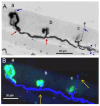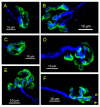Stable Convergent Polyneuronal Innervation and Altered Synapse Elimination in Orbicularis oculi Muscles from Patients with Blepharospasm Responding Poorly to Recurrent Botulinum Type-A Neurotoxin Injections
- PMID: 39728764
- PMCID: PMC11728458
- DOI: 10.3390/toxins16120506
Stable Convergent Polyneuronal Innervation and Altered Synapse Elimination in Orbicularis oculi Muscles from Patients with Blepharospasm Responding Poorly to Recurrent Botulinum Type-A Neurotoxin Injections
Abstract
Botulinum neurotoxin type-A (BoNT/A), which blocks quantal acetylcholine (ACh) release at the neuromuscular junction (NMJ), has demonstrated its efficacy in the symptomatic treatment of blepharospasm. In 3.89% of patients treated for blepharospasm at Tenon Hospital, BoNT/A was no longer effective in relieving the patient's symptoms, and a partial upper myectomy of the Orbicularis oculi muscle was performed. We used surgical waste samples from 14 patients treated with repeated injections of either abobotulinumtoxinA (Dysport®) or incobotulinumtoxinA (Xeomin®). These muscle fragments were compared to others from 4 normal subjects, naïve of BoNT/A. The morphological study was performed blinded to the BoNT/A treatment and between treated and control samples. Neuromuscular specimens analyzed by confocal laser scanning microscopy, using fluorescent staining and immune-labeling of presynaptic proteins, revealed that the pattern of innervation (e.g., polyneuronal and convergent innervation), the muscle nicotinic ACh receptors (nAChRs), and the NMJs exhibited marked differences in BoNT/A-treated muscles (regardless of the toxin clinically used), with respect to controls. BoNT/A-treated junctions exhibited profuse polyneuronal innervation in which 2-6 axons innervated 74.84% of single muscle fibers, while 99.47% of control junctions were mono-innervated. Another new finding was the stable convergent innervation, in which several motor axons end onto the same endplate. Morphological signs of synapse elimination included the presence of retraction bulbs in axons and nerve terminals and a reduced extension of postsynaptic nAChRs. These outcomes suggest that synapse elimination is altered and raise questions on the origin and factors contributing to the plasticity changes observed and the functioning of NMJs.
Keywords: blepharospasm; botulinum type-A neurotoxin; convergent innervation; human Orbicularis oculi muscle; myectomy; nerve sprouting; neuromuscular junction; nicotinic acetylcholine receptors; polyneuronal innervation; skeletal muscle; synapse elimination.
Conflict of interest statement
The authors declare no conflict of interest. The funders had no role in the design of the study, in the collection, analyses, or interpretation of data, in the writing of the manuscript, or in the decision to publish the presented results.
Figures












Similar articles
-
Effects of Repeated Eyelid Injections with Botulinum Toxin A on Innervation of Treated Muscles in Patients with Blepharospasm.Curr Eye Res. 2019 Mar;44(3):257-263. doi: 10.1080/02713683.2018.1543707. Epub 2018 Nov 23. Curr Eye Res. 2019. PMID: 30380945 Free PMC article.
-
Electrical activation of the orbicularis oculi muscle does not increase the effectiveness of botulinum toxin type A in patients with blepharospasm.Eur J Neurol. 2010 Mar;17(3):449-55. doi: 10.1111/j.1468-1331.2009.02840.x. Epub 2009 Nov 24. Eur J Neurol. 2010. PMID: 19968711
-
Evaluation of nerve innervation distribution of orbicularis oculi muscle for botulinum neurotoxin application using Sihler's method.Ann Anat. 2024 Jan;251:152165. doi: 10.1016/j.aanat.2023.152165. Epub 2023 Oct 5. Ann Anat. 2024. PMID: 37804929
-
[Treatment of focal dystonia with botulinum toxin A].Wien Klin Wochenschr. 2001;113 Suppl 4:6-10. Wien Klin Wochenschr. 2001. PMID: 15506045 Review. German.
-
More than at the neuromuscular synapse: actions of botulinum neurotoxin A in the central nervous system.Neuroscientist. 2015 Feb;21(1):44-61. doi: 10.1177/1073858414524633. Epub 2014 Feb 26. Neuroscientist. 2015. PMID: 24576870 Review.
Cited by
-
Botulinum Toxin Therapy: A Comprehensive Review on Clinical and Pharmacological Insights.J Clin Med. 2025 Mar 16;14(6):2021. doi: 10.3390/jcm14062021. J Clin Med. 2025. PMID: 40142828 Free PMC article. Review.
References
MeSH terms
Substances
LinkOut - more resources
Full Text Sources
Medical

